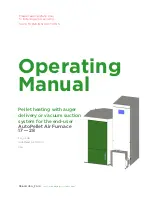
32
441 01 2101 05
Specifications are subject to change without notice.
a. LED will display previous status code 4 times.
NOTE
: If no previous code is present, go directly to b.
b. Inducer motor starts on high
−
speed and continues to
run
until Step g of component test sequence.
c. Hot surface igniter is energized for 15 sec., then off.
d. Blower motor operates on LO
−
HEAT speed for 10 sec.
e. Blower motor operates on HI
−
HEAT speed for 10 sec.
f. Blower motor operates on COOL speed for 10 sec.
g. Inducer motor goes to low
−
speed for 10 sec., then
stops.
h. Reconnect R lead to furnace control board, release
blower door switch and re
−
install blower door.
4. Operate furnace per instruction on inner door.
5. Verify furnace shut down by lowering thermostat setting
below room temperature.
6. Verify furnace restarts by raising thermostat setting
above
room temperature.
Step 3 — Adjustments
FIRE HAZARD
Failure to follow this warning could result in injury, death
and/or property damage.
DO NOT bottom out gas valve regulator adjusting
screw. This can result in unregulated manifold pressure
and result in excess over
−
fire and heat exchanger
failures.
!
WARNING
FURNACE DAMAGE HAZARD
Failure to follow this caution may result in reduced
furnace life.
DO NOT re
−
drill orifices. Improper drilling (burrs,
out
−
of round holes, etc.) can cause excessive burner
noise and misdirection of burner flames. This can
result in flame impingement of heat exchangers,
causing failures.
CAUTION
!
Furnace gas input rate on rating plate is for installations at
altitudes up to 2000 ft. (610 M). Furnace input rate must be
/
−
2% of furnace rating plate input. For altitudes above
5500 ft. (1676 M), a field
−
supplied high altitude pressure
switch is required.
1. Determine the correct gas input rate.
The input rating for altitudes above 2,000 ft. (610 M)
must be reduced by 4% for each 1,000 ft. (305 M)
above sea level.
For installations below 2000 ft. (610 M), refer to the unit
rating plate.
For installations above 2000 ft. (610 M), multiply the
input on the rating plate by the derate multiplier in Table
11 for the correct input rate.
2. Determine the correct orifice and manifold pressure
adjustment. All models in all positions except Low NOx
models in downflow and horizontal positions use Table
15 (22,000 BTUH per burner).
Low NOx models in downflow or horizontal positions MUST
use Table 16 (21,000 BTUH per burner). See input listed on
rating plate.
a. Obtain average yearly gas heat value (at installed
altitude) from local gas supplier.
b. Obtain average yearly gas specific gravity from local
gas supplier.
c. Find installation altitude in Table 15 or 16.
Table 12 – Altitude Derate Multiplier for U.S.A.
ALTITUDE
FT. (M)
PERCENT
OF DERATE
DERATE MULTIPLIER
FACTOR*
0–2000
(0-610)
0
1.00
2001–3000
(610-914)
8–12
0.90
3001–4000
(914-1219)
12–16
0.86
4001–5000
(1219-1524)
16–20
0.82
5001–6000
1524-1829)
20–24
0.78
6001–7000
(1829-2134)
24–28
0.74
7001–8000
(2134-2438)
28–32
0.70
8001–9000
(2438-2743)
32–36
0.66
9001–10,000
(2743-3048)
36–40
0.62
* Derate multiplier factors are based on midpoint altitude for altitude range.
d. Find closest natural gas heat value and specific
gravity in Table 15 or 16
e. Follow heat value and specific gravity lines to point of
intersection to find orifice size and low
−
and high
−
heat
manifold pressure settings for proper operation.
f. Check and verify burner orifice size in furnace.
NEVER ASSUME ORIFICE SIZE. ALWAYS CHECK
AND VERIFY.
g. Replace orifice with correct size, if required by Table
15 or 16. Use only factory
−
supplied orifices. See
EXAMPLE 1.
EXAMPLE 1:
(0
−
2000 ft. / 0
−
610 M altitude)
For 22,000 Btuh per burner application, use Table 15.
Heating value = 1000 Btuh/cu ft.
Specific gravity = 0.62
Therefore: Orifice No. 43*
Manifold pressure: 3.7
−
In. W.C. for high
−
heat
1.6
−
In. W.C. for low
−
heat
* Furnace is shipped with No. 43 orifices. In this example
all main burner orifices are the correct size and do not
need
to be changed to obtain proper input rate.
3. Adjust manifold pressure to obtain low fire input rate.
(See Figure 48)
a. Turn gas valve ON/OFF switch to OFF.
b. Remove manifold pressure tap plug from gas valve.
















































